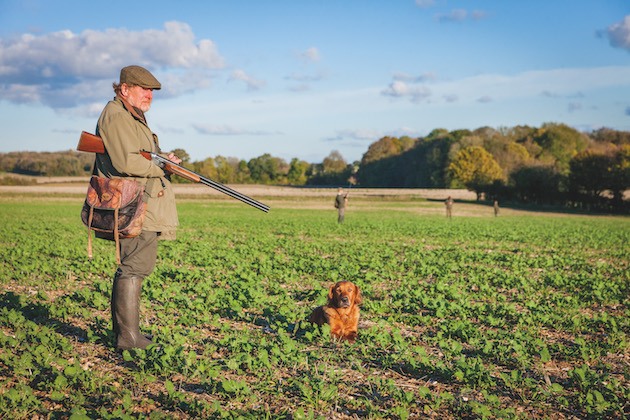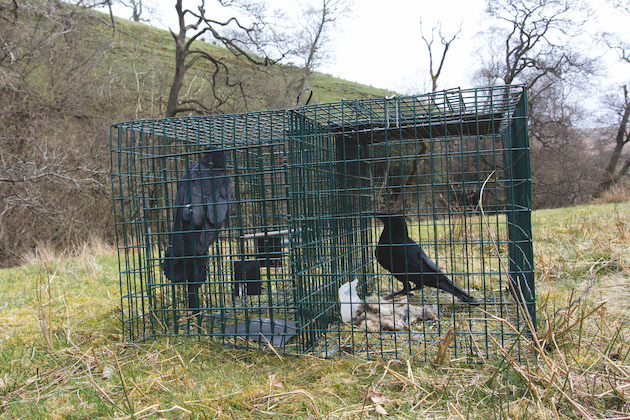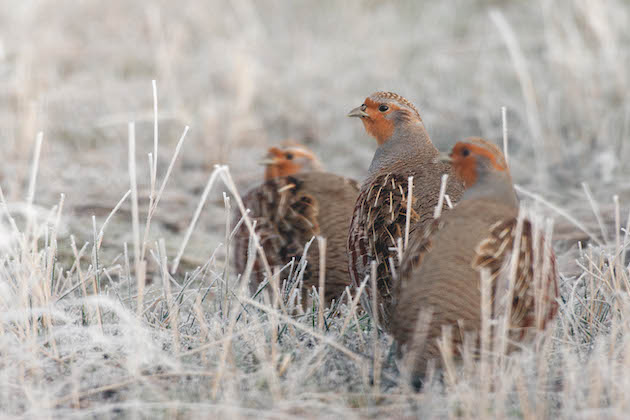When is the best time to shoot corvids?
I know this has nothing to do with pigeon shooting but I wondered if you could tell me the best…
Win CENS ProFlex DX5 earplugs worth £1,149 – enter here
 Mike Swan waiting on peg as the last hedge is walked up field winter oilseed rape.
Usd 27 dec 19 consevation
Mike Swan waiting on peg as the last hedge is walked up field winter oilseed rape.
Usd 27 dec 19 consevation
With the season all but over, my mind as usual turns to planning for the next. In just a few weeks, the pheasants will be setting up their territories, strutting their stuff and doing everything they can to keep their harems together. The corvids will be getting frolicsome too. Rooks start early, jackdaws a little later, and the crows and magpies will be getting increasingly territorial.
In two months from now, it will be Larsen trapping season — or will it? With the new rules under Defra’s open general licences for pest bird control, the central plank of my little wild bird rough shoot in Dorset is seriously undermined.
While I’m a passionate conservationist, the main reason for my predation control programme is to produce enough wild pheasants for four or five armed nature rambles with my friends. But the new licence for conservation purposes (GL40) is titled: “General licence to kill or take certain species of wild birds to conserve endangered wild birds, or flora and fauna.” Please note that word endangered — pheasants and redlegs are not on the endangered list.

Crows are frequently controlled using Larsen traps but this is now subject to the general licence
Other than for reasons related to protecting livestock, you can only control crows and magpies for the conservation of red or amber-listed “birds of conservation concern”.
With the grey partridges on the more open part of the shoot, the farmland birds such as skylark, corn bunting and the odd turtle dove, and the woodland birds like song thrush, marsh tit, dunnock and stock dove, I have ample reason to be running my Larsens as normal. If challenged, I am sure I can build a defence, but why should I? Since 1997, I have run an ever-growing game and wildlife conservation programme around my little wild bird shoot.
Apart from a few redlegs as cannon fodder in the first two seasons, not a single gamebird has been released on the ground. While I would not deny some of my neighbours’ birds have wandered on, I am not surrounded by big shoots. The local RSPB wood forms one boundary, while others are mostly unshot farms, though the new wild game beat of Cranborne estate is a welcome and exciting development.

Protecting grey partridges from common predators is a major concern
Today, we have grass and wild flower margins along almost all the field boundaries, strips of wild bird seed mix in a network with unharvested cereals across the whole shoot, several strips or plots of arable wild flowers and a whole lot more.
It is a carefully integrated farmland conservation scheme that takes up about 10% of the total farmland. Most of this is part of a mid-tier Countryside Stewardship scheme, but there is a significant amount of voluntary extra. After several years of absence, the corn buntings are back, yellowhammers and skylarks are on the up and stonechats bred this year for the first time.
My programme of fox control, tunnel trapping for rats and stoats, plus Larsen trapping for corvid control of crows and magpies, is surely benefiting a lot of other wildlife. But now, as an honest, working conservationist, I have to question my motives. Do I carry on with the corvid control for wild pheasants or say I am doing it to benefit other species?
Then there are the rooks, jackdaws and jays. I do not take many jays each year, but my only excuse now is to do so for a short list of endangered woodland birds, like song thrush and marsh tit. In the case of rooks and jackdaws, I have no conservation excuse. They have been removed from the conservation licence, though they remain on the licence to prevent serious damage (GL42).
I can say that I am controlling them to protect the boss’s chickens and to stop them from pulling up the spring beans and there will be truth in this at times. But what I really want to do is to keep their depredations on wild game in check — and, in this case, my wild grey partridges are a real concern.
Back in the days of the Euston system, where keepers took partridge and pheasant eggs to the safety of incubation under broodies, dummy eggs that were put in the nest to keep the bird sitting until hatch time were frequently found under the rookeries.
Defra and its Natural England advisers would no doubt say that there is no scientific evidence that the rooks and jackdaws are a significant problem and they would probably be right. However, there is no scientific evidence to the contrary.
Carrying out experiments to find out about this sort of thing is time-consuming and expensive. But what we do have is a significant amount of work, mostly carried out by the GWCT, which shows that when you control a suite of common predators, including these species, game and much other wildlife benefits. Our two key experiments in predator removal on Salisbury Plain in the 1980s and on the moors of Northumberland in the early 2000s showed that clearly.
I know this has nothing to do with pigeon shooting but I wondered if you could tell me the best…
How to take action against these predators
What Defra and NE are doing is to cherry pick that with no justification. They are making guesses as to which species matter and which do not, without any proper science to back it up. Much more seriously, they are saying control for birds that are not endangered is not justified, despite there being no legal basis to do so.
The enabling legislation for open general licences does not require that conservation licences are only granted for endangered species. The implication is a nonsense: we stop trying to conserve species with stable populations and wait until they are in decline before we take action. So where do we go from here? I want to be convinced that my normal activities are legal, so I shall be applying for an individual licence to control for pheasant and redleg conservation and I shall be putting all five common corvid species on the list to be controlled.
NE was due to post application forms on its website this month. It has also implied that it is unlikely to issue licences for species that are not of conservation concern. Apparently, it will be a two-stage process, with a pre-application that results in being told the likelihood of success, followed by a more detailed one. We can look forward to a logjam, delays and a year of disruption in the conservation of wild game due to licensing chaos.
Get the latest news delivered direct to your door
Discover the ultimate companion for field sports enthusiasts with Shooting Times & Country Magazine, the UK’s leading weekly publication that has been at the forefront of shooting culture since 1882. Subscribers gain access to expert tips, comprehensive gear reviews, seasonal advice and a vibrant community of like-minded shooters.
Save on shop price when you subscribe with weekly issues featuring in-depth articles on gundog training, exclusive member offers and access to the digital back issue library. A Shooting Times & Country subscription is more than a magazine, don’t just read about the countryside; immerse yourself in its most authoritative and engaging publication.

